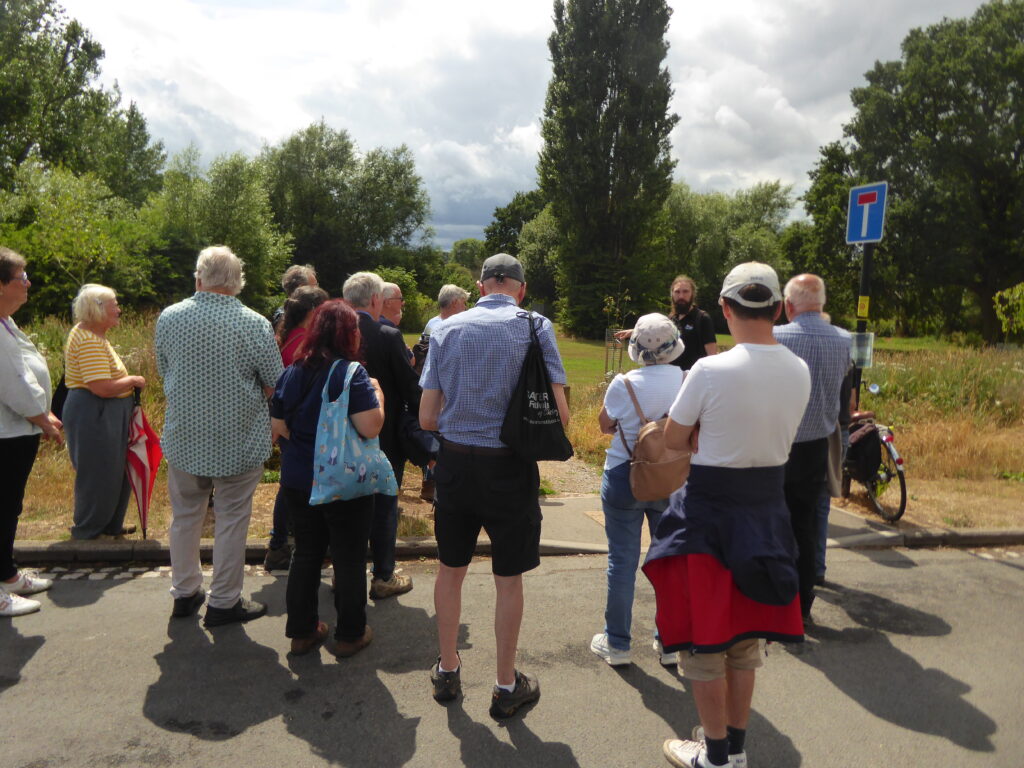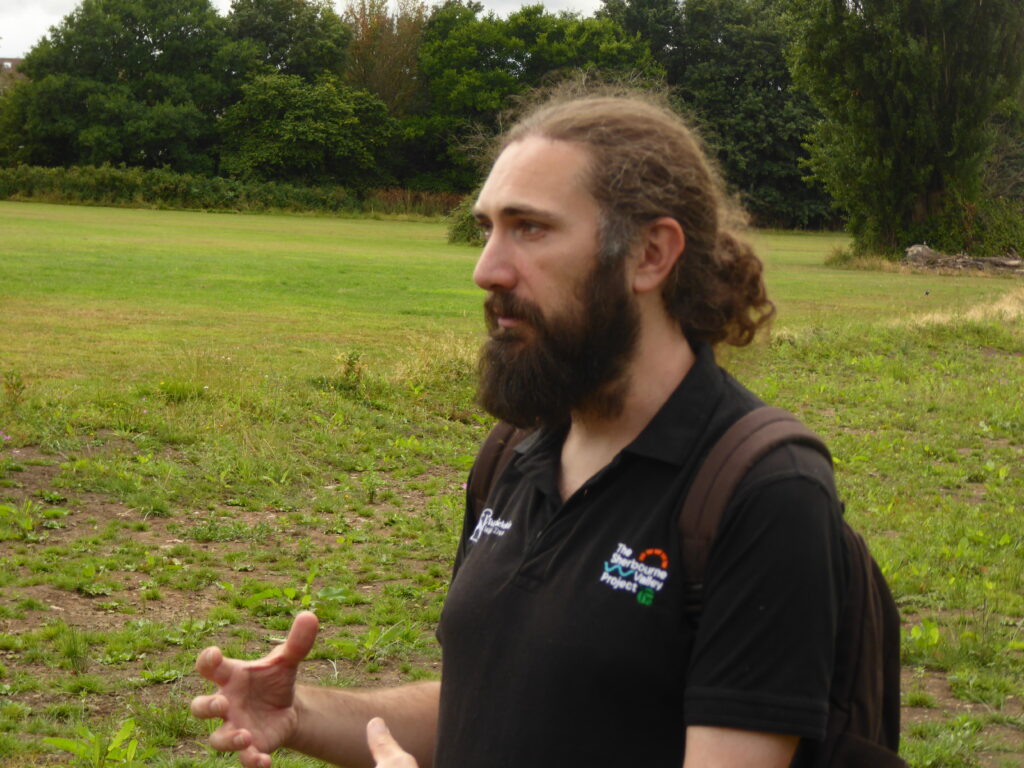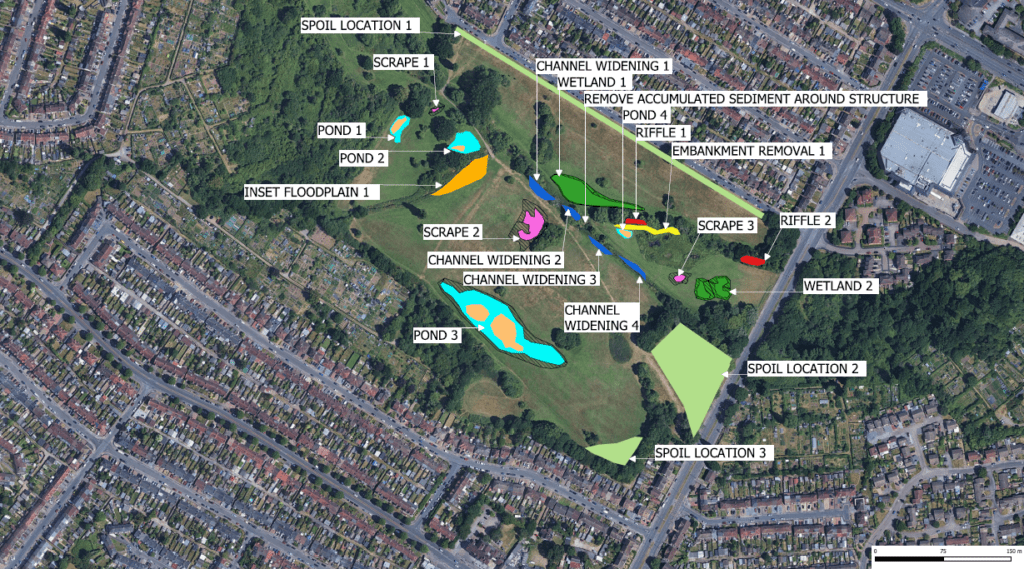
Twenty-four CovSoc visitors and guests were shown around Lake View Park on 17th July by Alex Jones of Warwickshire Wildlife Trust.
This year the Coventry Society’s theme for the year is the River Sherbourne. Following talks by the John Muir Trust and a tour of the Charterhouse Heritage Park, this month we focused on the work of the Sherbourne Valley Project in Lake View Park in Coundon.
Alex Jones is the Natural Heritage Officer for the Sherbourne Valley Project. His focus is on delivering “Wilder Wetlands” in the river valley.
Last year we reported on the plans submitted to the council to re-configure the park to create a wilder and more diverse environment for wildlife and a healthier river system in the park.
The plans include a suite of wetland features (ponds, scrapes, and wetlands) in addition to widening of the river channel of the main river Sherbourne at several points within the park.
The diggers were brought in over the last winter and spring. However, due to regulations, all the soil removed had to be kept within the boundaries of the park. This involved building a low bund along Lake View Road and spoil heaps in the top corner of the site. These have been planted with butterfly friendly species.

For our visit, shortly after the region was officially classed as being in a drought, the park was dry and the ground hard. Most of the recently created ponds were still dry. But people who regularly visit the park will know that it is usually a very wet environment, especially in winter. Alex described it as “already a wetland”. The real test of the scheme will come this winter, when the water returns.
Alex explained that the first step was to walk the area to observe the plant species and the areas which naturally get wet. They then undertook detailed Lidar surveys to model the elevations. A written report is then created with initial proposals. These are then modelled in detail by Dynamic Rivers, who are external consultant experts.
Alex explained that the first priority is to prevent the flooding of properties, so nothing is done which puts properties at additional risk. But that leaves plenty of scope for measures that improve the river. The modelling demonstrated that the scheme will make a positive improvement in reducing downstream flooding, although not by a great amount.
As well as the ponds and scrapes, the project also introduces “Riffle Structures”. A riffle is a rocky area of the river characterized by shallow depths with fast, turbulent water. Two riffles have been introduced by placing various pebbles and stones in these specific locations. These locations become ideal for fish breeding and providing oxygen-rich habitats for aquatic plants. They also enhance biodiversity supporting a wider range of species, from insects to larger fish. The turbulent water in riffles helps to aerate the river, improving water quality.
Another type of feature is known as “Inset Floodplain”. The banks of the river have been lowered to create an inset floodplain, just before the Guphill Brook meets the River Sherbourne. There will be minimal change in the overall height of the bank, but will instead set the bank back further from the channel to recreate a natural slope in which silt can be deposited and wildlife can access the river.
One of the projects we looked at was the re-opening of a previously blocked mill leat. The removal of silt from the opening of the leat has restored the flow of water in the channel and the creation of a gravel bed has allowed the establishment of a new spawning area for fish.
As well as the physical works, the scheme includes changes in the management of the park. At the moment most of it is “leisure mown” with short grass to allow ball games and picnics. In the future, it is hoped that more of it will be left to grow longer with a wider variety of species, that compete with grass. The removal of the cut grass at the end of the summer, would help to make the soil poorer, which is better for wildlife.
Although led by Warwickshire Wildlife Trust, the project involves a wide range of partners, not least the City Council who own and manage the park. There has been extensive community involvement, going beyond consultation to active participation by residents as volunteers. As a result of this engagement, the Friends of Lake View Park has now been officially registered as a charity.
The work on the project is largely funded by the National Lottery Heritage Fund.

